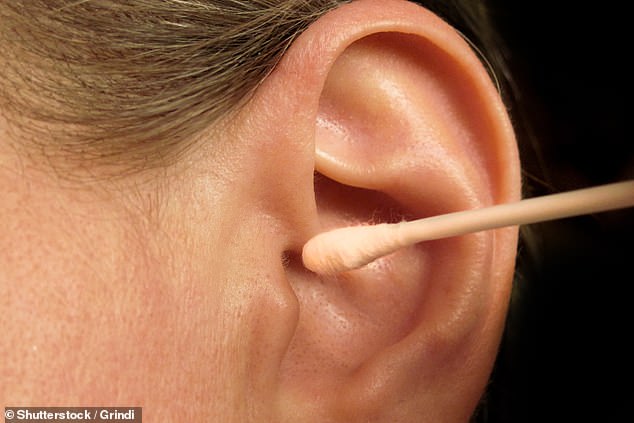Why you must NEVER use a cotton swab to clear out ear wax: Ask the GP DR MARTIN SCURR
As many people know all too well, hearing loss isn’t just about finding it difficult to hear the TV or respond to a phone call – it can make social interaction difficult (how many times have I heard patients and friends complain that they have difficulty (to hear) became so hard work that they simply stopped going out?), and could even be a matter of life and death.
Think of the shock we all feel when we are about to cross the road and suddenly an electric car, bicycle or scooter drives almost on top of us, unheard of.
That’s what hearing-impaired people experience when they leave the house. But imagine if that burden could be lifted in an instant, because the problem is actually a buildup of earwax?
This used to be something you could take to your GP or practice nurse to sort out. But not anymore. Although more than two million people are affected by earwax each year, syringes to remove affected earwax is a service that is no longer routinely offered.
This is because since 2019 injecting has been withdrawn as a service: I blame the GMS committee, the negotiating committee of the British Medical Association, which agrees terms of service for GPs and competes for reimbursement for all kinds of activities that GPs are expected to do. who could not have fought hard enough for this service.
This is despite the National Institute for Health and Care Excellence – the body that decides which services are available in the NHS based on cost and benefit – already calling hearing loss caused by earwax ‘frustrating and stressful’. ‘, adding: ‘If left untreated, it can contribute to social isolation and depression.

As many people know all too well, hearing loss is not just about finding it difficult to hear the TV or respond to a phone call; it can make social interaction difficult and even be a matter of life and death.

Although more than two million people are affected by earwax each year, syringing to remove affected earwax is a service that is no longer routinely offered
‘Providing earwax removal closer to home, in primary care or community ear care, will prevent the inappropriate use of specialist services.’
Now the service is only available in limited circumstances, for example if the patient is in severe pain due to an infection and the GP cannot see the eardrum due to earwax build-up.
In my opinion, this shows that doctors who spend their time in medical politics arguing over reimbursements and payments have lost touch with what their colleagues – busy treating sick patients – deal with on a daily basis.
A persistent buildup of earwax can cause significant problems, including hearing loss. That is why I think the national hearing loss charity RNID is rightly campaigning to reintroduce the NHS earwax removal service.
Earwax is secreted by glands in the skin lining the ear canal; it acts as a protective barrier against germs and dirt, and as it is produced, the older wax gradually migrates to the outside, where it is easily washed away.
But in some people this mechanism is defective: earwax builds up and eventually blocks the ear canal. All general practitioners have patients who regularly – every few months or perhaps every year – need to clear their ears of earwax.
Failure to do this puts the patient at risk for at least three problems. The first is hearing problems: according to a 2022 survey by the RNID, 73 percent of people had hearing loss due to earwax, and 37 percent had tinnitus.
The second danger is infection: if water from the bath, shower or swimming enters an ear that is partially clogged with earwax, it can become trapped, immediately resulting in almost complete deafness.
If left untreated, it can quickly lead to an infection (the warm, moist environment is an ideal breeding ground for bacteria), which can be painful and potentially serious.
Removing the blockage is important because it allows you to look inside the ear canal and diagnose what is going on. For example, if there is an infection, the eardrum may look red and swollen, and not shiny and white as normal.
Antibiotic treatment is also necessary because these infections can be very difficult to eradicate. In some, albeit rare, cases, a middle ear infection can lead to perforation of the eardrum and even sepsis or meningitis (the infection can spread towards the brain), which I have seen more than once.
The third – and possibly most common – danger of blocked ear canals is damage caused when the patient tries to unblock their ears themselves: I’ve seen the results of DIY attempts using everything from a cotton swab to a bent paper clip.
Not only do they damage the sensitive lining of the ear canal, but worse, they can also perforate the eardrum (again, not uncommon). The perforation does not always heal properly, resulting in long-term hearing loss. Think of a tambourine with a hole in it, the membrane can no longer vibrate to transmit sounds to the auditory nerve.
Because earwax can become ‘stuck’ to the skin of the ear canal, anchored by tiny hairs, doctors first treat it with drops to soften it and then rinse it out with water, using a device very similar to the ‘Waterpik ‘-jet dentists use. Or it can be sucked out using microsuction (a bit like a mini vacuum cleaner).
In some cases I would use a laundry hook. But all these techniques require precise knowledge of the anatomy – and awareness of the risks.
The advice now is that people try using drops to move the laundry themselves, with soothing drops bought from the pharmacy.
This may help in some, but not all, cases: in the same RNID survey, 20 percent of respondents who tried to remove wax themselves were successful and one in ten said their symptoms worsened or they injured themselves.
Many people end up going to one of the many commercial organizations that offer to remove earwax for a fee (around £60).
These are subject to site and staff checks by the Care Quality Commission, but not everyone who could benefit will be able to find, access or afford the service – and I worry about the understanding of the practitioners involved.
Pulling back on ear syringing is a good example of short-term gain leading to longer-term pain.
My view is that we need to bring this important part of healthcare back into the care of the NHS – and quickly.
Was wax the cause of my hearing loss?
By Doctor Michael Mosley
One of the really annoying things about getting older (I’m 66) is that I often have trouble hearing conversations in busy places.
When I’m in a restaurant or bar with my kids, they may be happily chatting, but I only catch about one in three words and end up just smiling and nodding – which is quite depressing and isolating.
Hopefully you’re not reading this over breakfast, because I recently discovered that part of the problem is earwax. I had a hearing test and after looking in my right ear, the audiologist sucked out a blob of earwax the size of a raisin.
I hadn’t realized it was there, which is probably a good thing since the audiologist strongly warned me never to try to pry earwax out with a cotton swab because you can end up just pushing it further into the ear canal, which can lead to all kinds of problems (see Dr. Scurr above).
In my case, removing the wax didn’t really matter. But then I went into a soundproof booth and put on some headphones for a proper test – this involves listening to sounds at different volumes and pitches and pressing a button when you hear something, no matter how faint.

‘It turns out I have significant hearing loss, especially at higher frequencies, which explains my difficulty distinguishing voices when there is a lot of background noise,’ says Dr Michael Mosley
My results weren’t terrible, but they weren’t great either: it turns out I have significant hearing loss, especially at higher frequencies, which explains my difficulty distinguishing voices when there’s a lot of background noise.
This is common as you get older and can also cause you to miss notifications on your phone or the doorbell. Birdsong can also become just a memory.
As many as 51 percent of Brits say they find it difficult to have conversations with background noise, and more than a quarter of us (28 percent) can’t hear the TV or radio well, according to new research from Specsavers (where you can get free have a hearing test done).
But despite these warning signs, most of us have never had our hearing tested.
Why does this matter? Not being able to hear is both isolating and bad news for your long-term health.
A study of more than 430,000 Britons published in the Lancet Public Health in April found that people with significant hearing loss were 42 percent more likely to develop dementia.
The good news is that the same study shows that using a hearing aid eliminates that extra risk. I don’t need one yet, but if I do, I will definitely get one.
Dr. MOSLEY has teamed up with Specsavers to encourage people to think about their hearing health.
